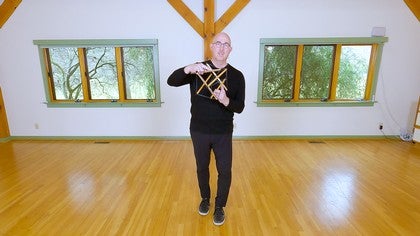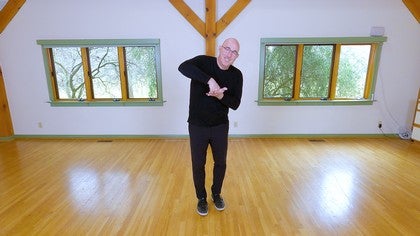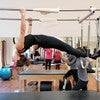Discussion #4990
Influencers of Healthy Knees
Description
About This Video
Transcript
Read Full Transcript
It's time to talk about things that help influence the knee to be healthy. And a lotta times, we hear of somebody having a knee injury or our knee hurts itself, and we go directly to the knee to treat it. I want you to shift the way you think about the knee, or any joint for that matter, and think about what are other things that influence the health of that joint. Today, of course, we're talking about things that influence health of the knee, so we're gonna get started with looking at influencers of the knee. There are five things that I wanna discuss at, again, a medium level.
Everything we're talking about here is, we could get lost, each of these could be a week long discourse, but I wanna touch on things that help us to think of what influences knee health. So we're gonna be talking about ankle mobility, hip mobility, ground reaction forces, what we wear in our feet, how we walk, how fast we walk, distribution of movement and how it equals distribution of force, a Polestar Principle of Movement, and then dynamic alignment, another Principle of Movement for Polestar. And as we go through each of these content areas, I want you to also be exploring with yourself to see how these particular areas could influence your knee health. The first one I wanna talk about, and I think is amazing, is the ankle Dorsi-flexion. It seems that by the time we turn five years old, six years old, we are told we have to sit in a chair for the rest of our life, and so we sit in a chair.
And during this important growth time of, you know, growth spurts, in between the ages of 10 and 15, we are sitting in a chair. If you look at this picture I have here of this child squatting, this is a very normal human squat, and most humans should be able to do this. However, those of us in the Western world, that have been forced to sit inside on chairs, lose the Dorsi-flexion. We no longer have a reason to squat down to the floor, and for this reason, I often look at the lack of ankle Dorsi-flexion as one of the primary causes of injury and disease to the knee. So before you start looking at the knee, take a quick look and see how the health of that ankle is.
Another little thing that I like to do is lift the heels up on a half roller or on a phone book or on a piece of two by four, just enough to where it eliminates the need for Dorsi-flexion of the ankle, and look at how the mechanics change in the knee, the hip, and the spine. It's amazing. And for that reason, one of the things we should always be working on with our clients is to get more Dorsi-flexion in the ankles. So, I'm gonna give you a challenge. You should, we all should, be able just to squat all the way down and come all the way back up.
And the question is, if the heels come up, or the back rounds out, or we have to get pushed back, that's probably a good indicator that we don't have enough ankle Dorsi-flexion. Another area that really has an incredible influence on the knee is the control of the hip, and in particular, control of the hip rotating in, right, so if we think of the eccentric control of the hip external rotators. It was Christopher Powers, a Professor at University of Southern California, who discovered why things like patella taping was working. And what he noticed was that the leading cause of knee pathology in sports was poor deceleration and eccentric control of the hip. So as this picture depicts, when that foot goes forward, when we're sort of runnin' or walking, and that knee collapses medially into what we call valgus load can create significant wear and tear in the knee.
And if we have an injury already of the knee, that particular load can continue to perturb or to irritate that particular joint or that injury, maybe of the medial collateral ligament we talked about in the anatomy portion, maybe the patella femoral joint, maybe the internal disc or the meniscus, particularly, on the medial side, and maybe even the anterior cruciate ligaments. So these are all things that, if you had the injury, and you didn't have good hip control, you could continue to exacerbate these symptoms over and over again. So, how do we do this? Well, in Pilates, we have so many great exercises that allow us to work on single leg control, right. One of my favorite, and I'll show it to you a little bit later, is a Tai Chi stance, opening up and maintaining alignment on the standing leg going through.
Again, it doesn't look necessarily like a knee exercise, but it is, because it's strengthening up the hip external rotators, as we would use them going downstairs, as we would use them running. If you think of running, running is just hopping back and forth on single leg, so it's single leg jumping. And again, what Christopher Power showed was that, if you can't decelerate on that single leg on multiple jumps and maintain your dynamic alignment, you have a high risk of incurring a knee injury. So in one of our companies in Polestar is called Runity, it's a running exercise training company. We've, my partner, Juan Nieto, has been on Pilates Anytime, you can see his trainings there.
One of the things we look at, in particular, are tests to see, if you could do a single jump on your leg for 100 jumps or 60 seconds straight of jumping at 180 beats per minute. That that might give us a good indication that you can maintain that alignment in that sagittal plane with that single leg deceleration jumping, and that would be a good indication that when you're running, you're probably not doing harm to yourself. And I would like to preface this, or I should have prefaced this, little late to preface it, is that I believe that squatting, and running, and jumping, and going up and downstairs, and walking, are all human rights of movement. So somewhere along the way, a child gains these, and somewhere along the way, we lose a lot of them, so usually, from things like knee pain. So hip control is a very important one.
Test your clients, see if they can stand and do a single leg squat multiple times, if they can jump on that leg, if they can do the Tai Chi exercise I'm gonna show you a little bit later, and the ankle one, if they can do a squat. I was talking about running, and one of the things we try to work with in our company, Runity, is how do we manage ground reaction forces? So ground reaction forces is every time that I push my foot in the ground, the ground gives me a reaction force that comes back up. If you think of watching elite runners or elite athletes, you might notice that they have a floating component to them, like they are just sort of flying on top of the earth. And what they've learned to do, and we'll talk about this in a second, is use their tensegrity, their biotensegrity, to be able to be very light and have a very short ground reaction time.
So the key is, for longevity of these joints, is how little time we can spend in our activities of having the heavy load into the foot. Now, I want you to think of the idea of jogging. Now, jogging is not a normal human movement. That was invented by shoe companies that made running shoes with big heels on 'em, so what happens is, when you're swinging through that leg, the heel stops, and you do a heel strike out in front of you. So a jog is very heavy, very high in ground reaction forces, very difficult on knees, right, and you see the people sort of slogging through those kind of jogs.
On the other hand, running, sprinting, and walking are all very normal gait patterns for humans, and one of the things we look at sometimes is barefoot running. And you would think that running without shoes or with minimal shoes would increase your ground reaction force, but in reality, the fact that we don't want that ground reaction force naturally, we change the way that we run or the way that we walk. So think about when you're walking barefoot through the house, or that if you've ever been outside running on the lawn barefoot, or even on concrete barefoot, we really change the way that we run, and that is a more natural way for humans to run. I'm not saying go out and run without shoes on. What I'm saying is that, how can we run and learn how to minimize our ground reaction force, so that we can have greater longevity?
On the other side of that, we also know that ground reaction forces can be good for us. So when we think of bone density, the person that is inactive and doesn't incur any ground reaction forces, doesn't build up elasticity in their tendons and their fascia and their muscles, doesn't build up bone density in their bones, and also will have the opposite effect. They don't get enough, so there's a nice balance between the two of having too much ground reaction force and not having enough. And one of the key elements is what I'm gonna talk about next. Distribution of movement equals distribution of force.
If you've ever taken a course with me or with Polestar, this is a phrase that resonates clearly through all Polestar graduates. And that is our Mobility Principle of Movement, and the idea is that, if I have five segments in my spine that move, then it's going to be a lot less stress on one segment. So for example, the average human being typically strategizes, moving from L4-L5, L5-S1, in the very low part of their back, with almost all of their forward bending. After doing Pilates, we did a study back in 1995, where we looked at this idea of, what does Pilates do to a strategy? And we found out that those who did one class of reformer work with five exercises increased the number of segments in their spine as part of their strategy by about 75%.
What did that do? Well, it decreased the movement of the L4-L5 and L5-S1 by 50%. So one of the things we know is that the better mobility we have in our feet, ankles, hips, low back, thoracic spine, the less stress is going to go through the knee, so a general whole body workout in Pilates is going to decrease the stress that would go through an injured part of the body. Since we're talking about the knee today the idea is that, if I have good mobility in my foot intrinsics and good mobility in my ankle, good mobility in my fibula and my tibia, good mobility in my hips in all directions, good mobility in my spine, the ground reaction force is going to be less in my knee, because distribution of movement equals distribution of force. This next topic of ways that we can create healthy knees is understanding the biotensegrity model.
So I have a tensegrity model here with me, and the idea of tensegrity and the whole study of fascia being a living component inside of our body is that it actually provides for us information, first and foremost. We know now that the fascia is filled with Golgi organs that give us proprioception about our verticality, about our axial elongation, and so when the body is organized correctly, it has the ability to absorb and disseminate and distribute forces, so that even with rotation, we have some control and elasticity that minimizes our destructive forces and improves our healthy forces. So we talked about trying to get ligaments and tendons to be nice and springy and trying to get bones to be nice and strong and how to work in harmony with the ground reaction force and not disharmony. So, let's think about this. If we take the idea of the tensegrity model, and we apply it to our body.
Many of you have taken courses that talk about fascia and the fascia trains, the anatomy trains, and we use those images of the diagonals of the myofascial system in the front and the back and the lateral and the middle and the posterior and the anterior, and all of these anatomy or fascial trains come together and respond to each other. And when there is an absorption in the leg, if we have good proper alignment, then we're gonna have better distribution through the tensegrity model. We're gonna have better elasticity. We're gonna rely on the muscle energy component much less, than if we are more elastic. So, let's think about that.
If I'm standing nice and straight, right, and I'm landing for my run, straight up and down, then the elasticity is going to be distributed through the whole body, right. But if I'm running here, and I'm heel striking my foot in front of me, and my weight's back behind me, now, I'm only loading one side. So that means I have stretch on this side, but I'm compressing the other side. So now, I don't have normal. I'm gonna be hitting bone on bone.
I'm gonna be creating abnormal forces, but if I come up into a nice straight position, then my elasticity is going to sustain my energy. It's gonna sustain the load, so that I'm not joint bone-on-bone or having one area that's inappropriately organized. And we talk about this as dynamic alignment, another principle inside of Polestar. So if I'm looking at the foot and ankle, is there good Dorsi-flexion of the ankle? If there's not, what I might end up doing is turning my feet out, because I don't have enough Dorsi-flexion, and I roll over my big toe.
And rolling over my big toe also puts my knee at a disadvantage to be valgus, right. It could also lose the ideal alignment and mobility of the fibula and tibia, so I no longer have that elasticity, right at the ankle joint here, when I'm running. I lose that relationship. I lose this relationship in the tib-fib. We can come up and look at the tibia-fibula, that we've already talked about anatomically, and the relationship of those two bones and the soft tissues that surround them up into the hip and the femur and the pelvis that controls the rotation.
If I lose my alignment, or I'm running all slouched over, and you see people running like this, really heavy, that's going to put a very abnormal stress on all the anterior structures of the body and a tensile stress on the back of the body with no elasticity. So the ground reaction force shoots through the ceiling in a destructive way, causing harm to the body. So a take home message here is that when we work on really good dynamic alignment. I'm not talkin' about static alignment. I'm talking about when we watch people move, we watch them jump, we watch them run, we watch them squat.
We're looking to see does the foot, ankle, fib-tib, tibia-femur, femur-pelvis, pelvis-sacrum, sacrum-lumbar, lumbar-thoracic, do they have a dynamic relationship that could imitate the biotensegrity model that exists inside of all of our bodies? And as we practice that upright posture, we're gonna see the biotensegrity model get stronger and stronger. The fascia is gonna be more responsive. The awareness is going to increase, and the amount of stress in our joint is going to decrease. Hence, it is a friend of the healthy knee, and we teach this all the time, whether we know it or not, in Pilates, when we're helping people with their posture.
So we've been able to understand some of the benefits that can help us have healthy bodies, and I think this is important, especially, if you're working with youth and children. How do we help them to have good mobility? How do we help them to understand the concept of distribution of movement equals distribution of force? How do we help them to understand that dynamic alignment is going to make them springy and floaty athletes and movers through space and have better, as Joseph Pilates said, better confidence about themselves and their bodies, if a child is practicing contrology every day. Likewise, these are very good powerful tools for us of understanding how we can create an ideal environment to prevent knee pathology.
How do we create an environment that allows our children to grow up without unnecessary wear and tear that is related to sedentary postures or to poor alignment or poor body awareness or lack of strength and awareness in activities? How do we create environments in our homes, where our children, instead of sittin' on a couch playing a computer game are squatting on the floor playing the computer game? These are ways that we can really change our environment, and it's, again, through education and through practice.
Knee Health: The Injured Knee and its Recovery
Comments
You need to be a subscriber to post a comment.
Please Log In or Create an Account to start your free trial.

















